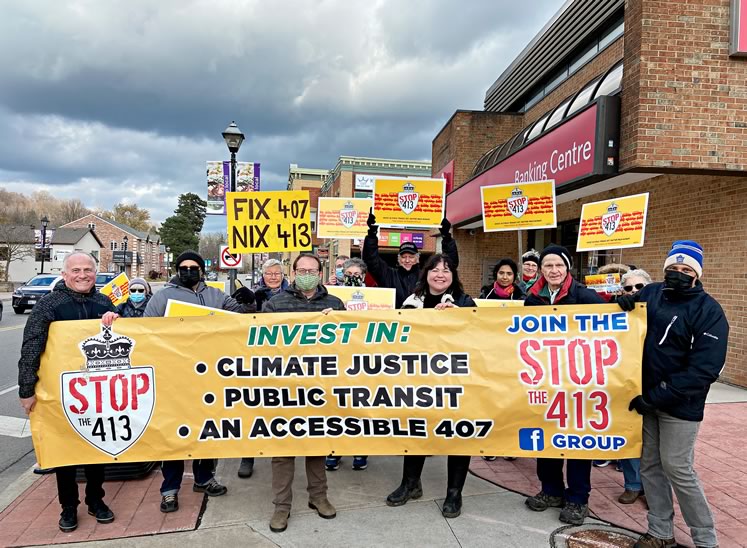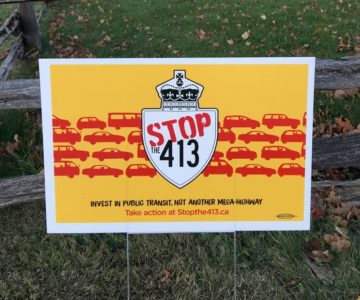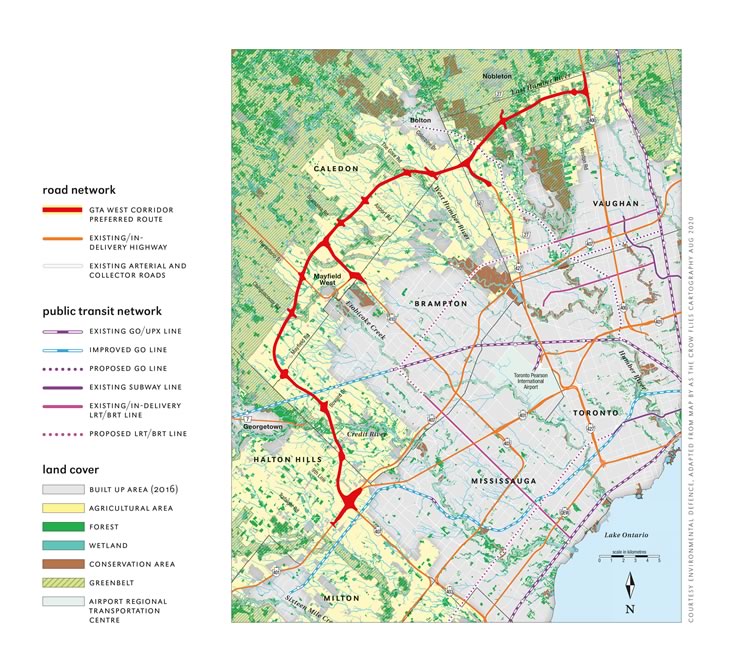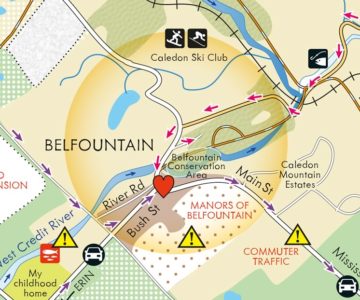Why Highway 413 is a Bad Idea
The “zombie” highway will hurt the environment, fail to solve the problems it aims to address – and there are better ideas to explore.
The spectre of a 400-series highway slicing through the south Caledon countryside has been hanging over our heads since it was brought back to life in 2019. The proposed GTA West Transportation Corridor, aka Highway 413, would span 59 kilometres from Highway 401 in Halton to Highway 400 in Vaughan. Caledon will host the longest section of the highway which also crosses the northwest corner of Brampton and a swath of the Greenbelt in Vaughan.

In November 2021 Caledon residents participated in a protest in Bolton calling on the Ford government to cancel Highway 413. Organized by Environmental Defence, protests against 413 and the Bradford Bypass were held the same day in Holland Landing, King City and Mississauga. Photo courtesy Jenni Le Forestier.
First proposed in 2007, the 413 has been dubbed the “zombie highway” for good reason. In 2016 the then Liberal government of premier Kathleen Wynne suspended the environmental assessment of the highway and appointed an expert panel to consider its future. The panel found that the environmental assessment had fatal flaws in how it determined the need for the highway and that it gave short shrift to a suite of alternatives.
The highway seemed as good as dead. But three years later, premier Doug Ford’s Progressive Conservative government not only revived the environmental assessment, it passed legislation to fast-track it. This would allow early works such as bridge building over watercourses to proceed prior to the completion of the assessment.
The government’s rationale for resurrecting the highway was twofold. The highway would reduce the acute congestion on Highway 401 that hampers the movement of goods and people, and this massive infrastructure project would inject an estimated $350 million in real GDP for every year of construction over five years.
Who could argue with that?
Well, a lot of people, it seems. Here’s a summary of the case against the 413.
1. It’s old-style planning
The provincial Growth Plan for the Greater Golden Horseshoe, which governs how and where growth is to occur, sets out goals for curbing urban sprawl in favour of complete communities, revitalized downtowns, and protecting natural spaces and farmland. Highway 413 advances none of these goals.
Instead, the construction of a $6−10 billion highway locks us into a road-oriented future that moves away from planning and building compact, transit-oriented communities. The 14 interchanges proposed along the length of the 413 will become meccas of truck-related industry and car-dependent subdivisions that will coalesce and expand outward.
The expert panel pointed out that in the years since the highway was first proposed, the basis for predicting future travel has evolved – a result of new technologies (automated cars and digital tools), remote working (a trend accelerated by the Covid-19 pandemic), and policy priorities related to climate change adaptation and mitigation, including smart growth and complete communities. All these undermine the originally conceived benefits of the highway in reducing congestion and saving travel time.
It is now also widely understood that building new highways to relieve congestion has the potential to make it worse. Called “induced demand,” in essence new highways create new commuters and, in as few as five years, congestion reaches the same levels as before, making any savings in travel time short-lived.
2. It’s bad for the environment and agriculture
Along its route, Highway 413 will cut across four watersheds including the Humber and Credit rivers and Etobicoke and Sixteen Mile creeks. Within its jurisdiction, Toronto and Region Conservation Authority says the highway will cross at least 85 streams and impact more than 220 wetlands, dozens of forests, woodlots and wildlife habitats, as well as cultural heritage sites of the Mississaugas of the Credit First Nation.
The highway will also remove more than 400 acres of Greenbelt, including a portion of the Nashville Conservation Reserve in Vaughan – reversing a promise Premier Ford made in 2018. “The people have spoken,” he said. “I’m going to listen to them. They don’t want me to touch the Greenbelt, we won’t touch the Greenbelt.”
Thousands of acres of prime agricultural land will also be destroyed inside and outside the Greenbelt. The Ontario Federation of Agriculture estimates that 175 acres of the province’s farmland are already lost daily to development, a trend that threatens the long-term stability of the agricultural sector and food security in the GGH.
“We try to promote homegrown food … How are we going to feed people? Once the land is gone, it’s gone forever” says Allan Ehrlick, president of the Halton Region Federation of Agriculture. (In late February, Halton Region voted to reject any urban boundary expansion that would allow growth onto farmland.)
The OFA estimates farmland in the GGH contributes $1.6 billion in ecological services annually. These services include carbon sequestration in soils and biomass, habitat for wildlife including species at risk and pollinators, erosion control and recreational activities. The loss of these services, in addition to the estimated 17.4 million tonnes of greenhouse gases that will be produced over 30 years by cars and trucks using the 413, will challenge Ontario’s ability to meet its mandated targets in response to climate change.
Transportation is also one of the primary sources of air pollution in the GTA. “People who live close to highways suffer greater health impacts from air pollution, and will experience higher risk of diseases like asthma, lung cancer and heart disease,” according to the Canadian Association of Physicians for the Environment.
In many ways, Highway 413 is the poster child for Premier Ford’s “open for business” agenda – an agenda that has steadily and significantly undermined Ontario’s regulatory system for protecting the environment.
The government has curtailed conservation authorities’ ability to protect ecologically significant features and gutted legislation for the protection of species at risk. It has weakened policies and standards in the Growth Plan to curb urban sprawl. And it has accelerated more than 40 development applications through the use of Minister’s Zoning Orders, effectively circumventing local planning control, public consultation and powers of appeal.
Sweeping changes to the Environmental Assessment Act (appended into the government’s omnibus 2020 Covid-19 Economic Recovery Act) are aimed at fast-tracking major projects such as Highway 413 and the Bradford Bypass, another major highway in the Greenbelt, similarly revived by the Ford government.
3. Public opposition is overwhelming
Virtually every major environmental organization has spoken out against the highway, including Environmental Defence, the David Suzuki Foundation, Ontario Nature, Sierra Club Peel and the Federation of Urban Neighbourhoods. An online petition from the David Suzuki Foundation has garnered over 11,750 signatures so far, and an active coalition of community groups has formed in opposition to the highway.
The Ontario Federation of Agriculture and its Peel chapter have called for an agricultural impact assessment. Other farming organizations, such as the Ontario Farmland Trust, Ecological Farmers Association of Ontario and the National Farmers Union, have also registered their strong opposition to the highway.
“The 413 infrastructure project constructed right through the Greenbelt will only lead to the eventual chipping away of protected lands,” says Janet Horner, Mulmur mayor and executive director of the Golden Horseshoe Food and Farming Alliance. Although the GHFFA is not mandated to take a position on the 413, Horner personally notes, “Its construction will lead to a complete disregard of the natural heritage and agricultural systems in Peel and Halton regions.”
Even among the municipalities that would arguably benefit economically from the highway, support is emphatically divided. Along the highway’s route, Halton and Vaughan are opposed to it, as are the Region of Peel and neighbouring municipalities of Orangeville, Mono, King, Mississauga and Toronto.
Caledon and Brampton remain officially onside with the highway, but their councils are split.
In late January, Brampton council voted on a motion to reverse its support for the highway, in part because the route cuts through the heart of Heritage Heights, a new town centre proposed as a complete, mixed-use, high-density community that integrates natural spaces. The council vote was evenly split, but the motion was lost when mayor, and former provincial Conservative leader, Patrick Brown cast the deciding ballot.
Caledon Mayor Allan Thompson is likewise a vocal supporter of the 413. With Caledon’s population slated to skyrocket to 300,000 by 2051, most of it at the south end, he asks, “How can we accommodate so many people without having some kind of infrastructure corridor?”
Still, with three of the town’s eight councillors adamantly opposed – Annette Groves, Ian Sinclair and Tony Rosa – as well as another, Christina Early, declaring a conflict of interest, and with a municipal election set for this fall, the town’s continued support for the highway is not a given.
In the meantime, both Caledon and Brampton did support the call for a federal environmental review, which was granted in May 2021 and will determine if a full federal impact assessment is warranted.
Not one to bow to public pressure, and with all three opposition parties vowing to kill the highway (again), Ford seems to be positioning the highway as a wedge issue that would gain him support in the coming election from the critical 905 region.
But the 905ers may not be the folks Ford thinks he knows. An Ekos poll conducted in December 2021 shows that 72 per cent of the car-driving population in the 905 area agree there’s a climate emergency and 74 per cent said the Greenbelt is no place for a 400-series highway.
So if not voters, who is Ford listening to?
Of eight prominent GTA land developers who own thousands of acres near the proposed highway, at least four have close ties to the Ford government, according to a Toronto Star/National Observer investigative report published in April 2021. The report notes, “Most of the developers in the group are also prolific PC donors, contributing at least $813,000 to support the party since 2014.” The highway and its associated urban growth would represent a huge windfall to speculators, many of whom are likely to underwrite the upcoming provincial election.
4. It will change Caledon forever
Caledon has a lot to lose if Highway 413 is built. The highway will sterilize and pave the way for development on a quarter of the town’s prime agricultural land – close to 10,600 acres.
And with half the total length of the 413 located in Caledon, the town will effectively be split in two, isolating southern communities from the rest of the town. Mayfield West, for example, will be completely encircled by 400-series highways.
And in spite of the protections afforded by the Greenbelt, the Niagara Escarpment and the Oak Ridges Moraine planning areas, residents in the northern part of Caledon will not escape the impact of the highway.
Thirty-nine per cent of the province’s active pits are located in the Greenbelt and Caledon is one of the top producing municipalities within 50 kilometres of the proposed highway. With an estimated 2.4 million tonnes of aggregate, or 104,000 truckloads, needed to build the 413, the town will face increased pressure to open up new pits and quarries. This is bad news for citizens already battling applications for new and expanded operations near the villages of Alton, Belfountain and Cataract.
Furthermore, with eight of the 14 interchanges on Highway 413 connecting to Caledon’s road system, the town can expect a marked increase in flow-through traffic along its north-south roads. A City of Vaughan transportation study, for example, looked at the effect of the 413 on its internal transportation network and found that two indicators of congestion – total vehicle-kilometres travelled and total vehicle-hours travelled – would increase by 40 per cent and 35 per cent respectively.
As a Caledon staff report warned, the extra traffic will require substantial upgrades and maintenance on the town’s roads. Peel and Caledon’s taxpayers will be on the hook for the costs. The additional traffic will also exacerbate noise, light and air pollution, salt runoff and wildlife collisions.
However, even more than the physical impact of increased traffic and aggregate mining, the highway threatens a deeper, almost existential assault on the essential character of Caledon that residents treasure and visitors seek – its open countryside, the sense of connection to an agrarian past, and the prevailing reverence for nature.
5. There is a better way
Investing in a highway is not the only way to create jobs and move goods and people.
Perhaps most notably, the expert panel found that adding dedicated truck lanes on Highway 407 would “deliver significant travel time savings, especially for the goods movement sector.” The chronically underutilized toll highway, privatized by the provincial government in 1999, is just 14 kilometres south of the proposed 413 at its farthest point. A report from Transport Action Ontario calculates that subsidizing truck tolls on the 407 over the next 30 years would cost the province half that of constructing and maintaining Highway 413.
As for moving people, the Metrolinx Regional Transportation Plan, includes seven unfunded rapid transit projects that together cost roughly the same as Highway 413. Collectively these projects would link the outer and inner ring GGH communities of Milton, Kitchener, Brampton, Dundas, Vaughan and Bolton, and move 22,000 to 29,000 people per hour compared to 7,000 people per hour using the 413.
“Investing in these rapid transit projects would move four times as many people as the highway for a comparable price,” says Peter Miasek, president of Transport Action Ontario. These transit projects would go a long way to taking thousands of commuters off GGH highways and opening up existing highways for goods movement while contributing the same economic value as building the highway with far fewer social and environmental costs.
Caledon has long prided itself on being an environmental leader. It has declared a climate emergency and set a carbon target of net zero by 2050. Its Climate Action Plan calls for the development of low carbon transportation alternatives, protection of natural lands and a resilient food and agriculture sector. If this is the Caledon residents want and are proud to call home, how then is there a place in it for Highway 413?
HIGHWAY 413 BY THE NUMBERS
8
number of the 14 interchanges on Hwy 413 that connect to Caledon roads
$8.6 billion
minimum estimated cost to build and maintain Hwy 413 for 30 years
$4 billion
estimated cost of subsidizing truck tolls on the nearby, underutilized Hwy 407 for 30 years
14
maximum distance in kilometres between Hwy 413 and Hwy 407
220
wetlands that will be impacted by Hwy 413 within the jurisdiction of the Toronto and Region Conservation Authority
10,600
acres of Caledon’s prime farmland that will be lost to the highway and associated development
17.4 million
estimated tonnes of greenhouse gas emissions Hwy 413 traffic will generate by 2050
2.4 million
tonnes of aggregate required to build Hwy 413
4,000+
acres in Caledon currently licensed for aggregate mining of 15,000+ acres protected as high priority aggregate resource areas
40+
Minister’s Zoning Orders the provincial government has used to override local planning controls
4
number of the 8 Caledon councillors who either oppose (3) Hwy 413 or have declared a conflict of interest (1)
300,000
population of Caledon by 2051 as directed by the Region of Peel to accommodate growth mandated by the 2019 provincial Growth Plan for the Greater Golden Horseshoe
275
percentage increase in Caledon’s current population by 2051
2050
year Caledon plans to reach its net zero carbon goal
Related Stories

Highway 413: The Opposition Reloads
Nov 24, 2020 | | EnvironmentThe Ford government has resurrected the controversial highway that will cut through south Caledon. Is it a done deal?

Conservation Authorities v. Doug Ford
Mar 31, 2021 | | EnvironmentThe provincial government is stripping Ontario’s conservation authorities of the very meaning of their name – and key protections for the environment.

No Green Recovery
Mar 31, 2021 | | Editor’s DeskThe Ford government has navigated Covid as well as or better than many – but at the same time, it has also escalated its pro-development agenda.

Letters – Our Readers Write: Spring 2021
Mar 31, 2021 | | Letters, Our Readers WriteLetters published in the Spring 2021 edition of In The Hills magazine.














What an incredibly well-researched and well-written submission. I can’t find the author’s name.
Betty de Groot from Bolton on Apr 3, 2022 at 12:15 pm |